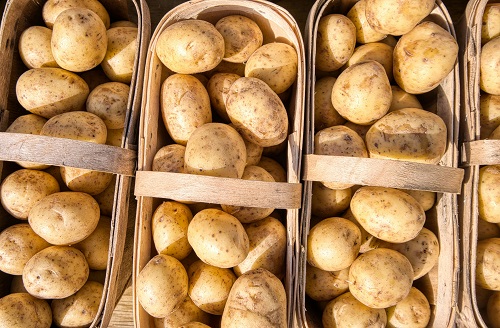Irish Potato Farming

Type: Agricultural Production.
Key Products for Sale:
- Fresh Irish Potatoes: Varieties including Russet, Yukon Gold, and Red Bliss.
- High-Quality Seed Potatoes: Certified disease-resistant seed potatoes for home gardeners and other farmers.
- Value-Added Potato Products: Pre-cut potato packs, specialty potato varieties, and branded packaged potatoes for retail and food service sectors.
Technology Considerations:
- Precision Farming Technology: Utilizing GPS-guided tractors and planting equipment for accurate seed placement and spacing.
- Climate-Controlled Storage: Implementing modern storage facilities with temperature and humidity control to prolong shelf life.
- Crop Monitoring Systems: Installing sensors and drones for real-time monitoring of crop health, water usage, and pest infestation.
- Mobile Apps for Farm Management: Utilizing mobile applications for crop scheduling, inventory management, and market analysis.
Market for the Products:
- Local Consumers: Supermarkets, farmers’ markets, and restaurants catering to consumers seeking fresh, locally-grown produce.
- Wholesale Buyers: Food distributors, grocery chains, and institutional buyers sourcing potatoes for retail and food service operations.
- Export Markets: International buyers interested in high-quality Irish potatoes and value-added potato products.
Key Inputs into the Business:
- High-Quality Seed Potatoes: Procurement of certified disease-free seed potatoes from reputable suppliers.
- Fertilizers and Soil Amendments: Organic and conventional fertilizers to enrich soil fertility and promote healthy potato growth.
- Irrigation Systems: Installation of drip irrigation systems or pivot sprinklers for efficient water management.
- Labor: Skilled workers for planting, harvesting, grading, and packaging operations.
- Packaging Materials: Containers, crates, and labels for packaging fresh potatoes and value-added products.
Product Preparation Process:
- Land Preparation: Soil tillage, amendment, and preparation for planting.
- Planting: Sowing certified seed potatoes in rows or beds using modern planting equipment.
- Crop Maintenance: Irrigation, fertilization, pest control, and weed management throughout the growing season.
- Harvesting: Mechanical or manual harvesting of mature potato crops at peak quality and size.
- Storage and Packaging: Sorting, grading, and packaging potatoes according to size and quality standards for sale to customers.
Quality Considerations:
- Seed Selection: Choosing certified disease-free seed potatoes to ensure healthy crop establishment and high yields.
- Crop Monitoring: Regular monitoring of crop health, nutrient levels, and pest infestation to identify and address issues promptly.
- Post-Harvest Handling: Gentle handling and proper storage to prevent bruising, sprouting, and decay during storage and transportation.
- Packaging and Presentation: Packaging potatoes in clean, sturdy containers with proper labeling to maintain product freshness and appeal to customers.
Cost of Investment:
- Land Acquisition or Lease: Variable costs depending on the location and size of the farm.
- Infrastructure Development: Estimated investment of between KES 500,000 and KES 2,000,000 for greenhouse construction, storage facilities, and irrigation systems.
- Equipment Purchase or Leasing: KES 300,000 – KES 1,000,000 for tractors, planters, harvesters, and storage equipment.
- Seed Procurement: KES 50,000 – KES 200,000 for purchasing certified seed potatoes.
- Labor Expenses: Annual labor costs of KES 100,000 – KES 500,000 depending on farm size and labor requirements.
- Marketing Expenditures: Budget of KES 50,000 – KES 200,000 per year for branding, promotion, and market research.
Required Operational Infrastructure:
- Potato Fields or Greenhouses: Growing areas for potato cultivation.
- Irrigation Systems: Water distribution infrastructure for efficient crop watering.
- Storage Facilities: Climate-controlled storage areas for storing harvested potatoes.
- Processing Equipment (if applicable): Grading machines, washers, and packaging equipment for value-added products.
- Transportation Vehicles: Trucks or vans for delivering products to markets and buyers.
Most Suitable or Viable Location of the Business:
- Regions with Favorable Climate: Areas with temperate climates and well-drained soils conducive to potato cultivation.
- Access to Water Sources: Proximity to reliable water sources such as rivers, lakes, or aquifers for irrigation.
- Proximity to Markets: Convenient access to local markets, wholesale buyers, and transportation networks for efficient product distribution.
Potential Sources of Investment Capital:
- Personal Savings: Self-funding the business with personal savings or investments.
- Agricultural Loans: Securing loans from banks or financial institutions specializing in agriculture.
- Government Grants: Exploring grants and subsidies available for agricultural startups and sustainability initiatives.
Partnership Opportunities: Collaborating with investors or agricultural organizations for funding and support.
Requirements for Effective Management:
- Agricultural Expertise: Knowledgeable farm managers and agronomists with experience in potato cultivation.
- Business Management Skills: Effective leadership, financial management, and strategic planning.
- Marketing Strategies: Branding, promotion, and distribution strategies to reach target markets.
- Quality Control Measures: Monitoring crop health, processing standards, and product quality.
- Customer Relationship Management: Building strong relationships with buyers and consumers.
Role of Mobile Phones and ICT in the Business:
- Farm Management Apps: Tools for monitoring crop growth, irrigation scheduling, and pest control.
- Market Research: Accessing market information, pricing trends, and consumer preferences.
- Online Marketing: Utilizing social media, websites, and e-commerce platforms to promote products and engage customers.
- Communication: Facilitating communication with suppliers, buyers, and agricultural experts.
Statutory Regulations and Licenses:
- Agricultural Regulations: Compliance with local agricultural laws, crop safety standards, and environmental regulations.
- Business Licensing: Obtaining permits and licenses for operating a farm, processing facility, and food business.
- Food Safety Standards: Adhering to hygiene practices, labeling requirements, and quality control measures.
Pricing:
- Competitive Pricing: Setting prices based on production costs, market demand, and product quality.
- Value-added Pricing: Premium pricing for specialty potato varieties and value-added products with added convenience and quality.
Profitability:
- Estimated Annual Profits: Depending on farm size, production volume, and market conditions, profits can range from KES 500,000 to KES 2,000,000 or more.
- Profit Margin: Aim for a profit margin of 20-30% by optimizing production efficiency, minimizing costs, and maximizing revenue.
Next Steps to Take:
- Secure Land and Infrastructure: Acquire or lease suitable land and establish necessary infrastructure for potato farming.
- Source Inputs and Equipment: Purchase seeds, irrigation systems, and other inputs required for cultivation.
- Implement Crop Management Practices: Follow best practices for soil preparation, planting, and crop maintenance.
- Develop Marketing Strategies: Create a branding and promotion plan to attract buyers and build market presence.
- Monitor Performance: Track crop growth, sales, and financial metrics to assess business performance and make informed decisions.
- Expand and Diversify: Explore opportunities for expanding product offerings, entering new markets, or integrating vertical operations to enhance profitability and sustainability.

